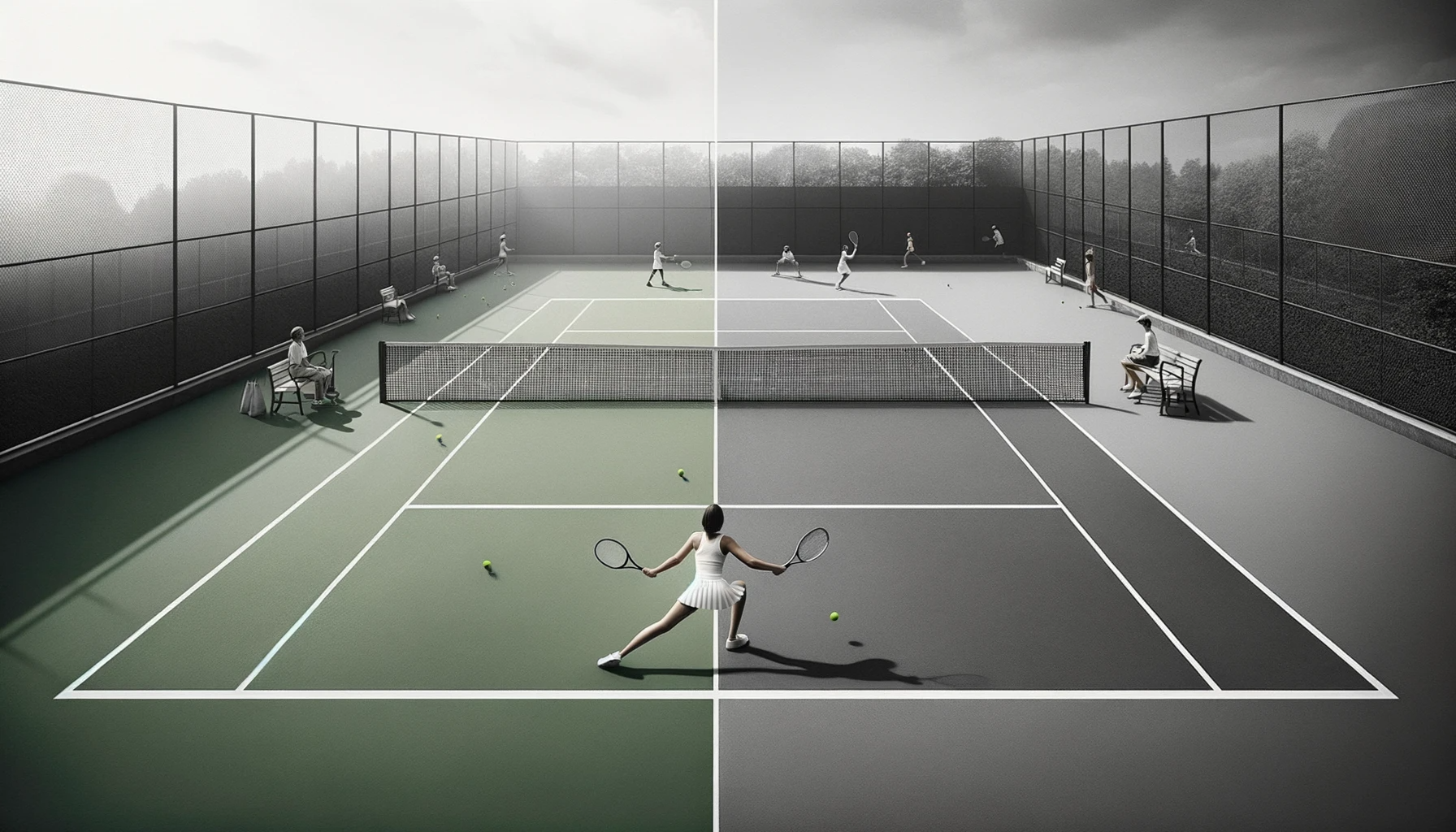Dive into the exhilarating world of tennis as we unravel the secrets to mastering this captivating sport in our comprehensive guide, ‘Get Started!’ Tennis Basics 101.
Like a well-executed backhand, this article will serve you with essential knowledge, expert tips, and practical drills to develop your skills on the court.
From understanding the equipment and rules to perfecting your footwork and strokes, this instructional piece promises to equip aspiring tennis enthusiasts with the fundamentals they need to ace their game.
Key Takeaways
- Choose the right tennis equipment for your playing style and surface.
- Familiarize yourself with the dimensions of a tennis court and understand the scoring system.
- Learn and practice different tennis strokes and techniques, such as forehand, backhand, volleys, and overhead smash.
- Develop strategies and tactics for playing from the baseline, approaching the net, defensive shots, court positioning, and shot selection.
Equipment You Need
When starting out in tennis, it is important to have the necessary equipment in order to play the game effectively. Two key aspects of equipment to consider are tennis court dimensions and proper grip techniques.
Tennis court dimensions play a crucial role in determining the layout and size of the court. According to the International Tennis Federation (ITF), the standard dimensions for a tennis court are 78 feet long and 36 feet wide for singles matches, and 78 feet long and 27 feet wide for doubles matches. It is important to familiarize yourself with these dimensions to understand the boundaries and positioning during gameplay.
Equally important is mastering proper grip techniques. The grip is the foundation of your strokes and can greatly influence your performance. The most common grip is the Eastern grip, where the base knuckle of the index finger is placed on the third bevel of the racket handle. This grip provides versatility and control for various shots. However, there are other grips like the Western grip for topspin shots and the Continental grip for volleys and serves.
Basic Rules and Scoring
To fully grasp the fundamentals of tennis, it is essential to understand the basic rules and scoring system of the game. Here are some key points to help you understand the rules and scoring in tennis:
- Understanding the different court surfaces: Tennis can be played on various court surfaces, including grass, clay, and hard courts. Each surface has its own characteristics that affect the speed and bounce of the ball, requiring players to adjust their strategies accordingly.
- The role of the chair umpire in tennis matches: The chair umpire is responsible for ensuring fair play and enforcing the rules during a tennis match. They make important decisions, such as calling lines and overruling the lines judges’ decisions. The chair umpire also keeps track of the score and announces it to the players and spectators.
- Scoring system: Tennis uses a unique scoring system, with points, games, and sets. Players earn points by winning rallies, with the first player to reach four points winning the game. To win a set, a player must win six games, with a margin of at least two games. In most matches, players compete in a best-of-three sets format.
- Tiebreakers: If the score reaches six games all in a set, a tiebreaker is played to determine the winner of the set. In a tiebreaker, players continue to earn points, with the first player to reach seven points, with a margin of at least two points, winning the tiebreaker and the set.
- Match format: Tennis matches can vary in format, with some tournaments using a best-of-three sets format, while others use a best-of-five sets format for the men’s matches. The format for each match is determined by the tournament or competition rules.
Understanding the basic rules and scoring system of tennis is crucial for any player or fan of the game. By familiarizing yourself with these rules, you will be able to fully enjoy and appreciate the sport.
Essential Tennis Strokes
The mastery of essential tennis strokes is crucial for players to effectively execute their strategies and navigate the complexities of the game. Two key elements that players must focus on are grip and technique.
The grip is how a player holds the racket, and it can greatly influence the power and control of their shots. The most common grip is the Eastern grip, where players hold the racket with their knuckles aligned with the strings.
Technique, on the other hand, refers to the proper execution of the strokes. Each stroke has its own specific technique, such as the forehand, backhand, serve, volley, and overhead smash. Players must practice these techniques diligently to develop consistency and accuracy.
Another important aspect of essential tennis strokes is shot selection and strategy. Shot selection refers to the decision-making process of choosing which stroke to use in a particular situation. Factors like the opponent’s position, the speed and spin of the incoming ball, and the player’s own strengths and weaknesses all come into play when making shot selections.
Strategy, on the other hand, involves the overall plan a player employs to win a match. This includes tactics like attacking the opponent’s weaknesses, playing to one’s own strengths, and varying the pace and placement of shots.
Footwork and Positioning
Effective footwork and positioning are essential for tennis players to optimize their performance on the court. By developing proper footwork and positioning techniques, players can improve their agility and court awareness, enabling them to move quickly and efficiently during a match. Here are some key points to consider:
- Agility training: Agility is crucial in tennis as it allows players to change direction rapidly and reach difficult shots. Incorporating agility exercises into your training routine, such as ladder drills, cone drills, and lateral movements, can enhance your footwork and overall agility on the court.
- Court awareness: Being aware of your position on the court is vital for effective footwork and positioning. Understanding the different court areas, such as the baseline, mid-court, and net, and knowing when to move forward or retreat can help you anticipate your opponent’s shots and respond accordingly.
- Balance and stability: Maintaining a stable and balanced stance is crucial for executing shots accurately and efficiently. Focus on keeping your weight centered and distribute it evenly between both feet. This will allow you to move quickly and change direction smoothly without losing balance.
- Proper positioning: Positioning yourself correctly on the court is key to being in the right place at the right time. Anticipate your opponent’s shots and adjust your positioning accordingly. By being in an optimal position, you can maximize your chances of reaching and returning shots effectively.
- Practice and repetition: Developing good footwork and positioning skills requires regular practice and repetition. Incorporate drills and exercises specifically designed to improve your footwork and court positioning into your training routine. Consistent practice will help you develop muscle memory and instinctively know where to move on the court.
Practice Drills and Tips
Developing solid practice drills and implementing effective tips is crucial for tennis players to improve their skills and elevate their performance on the court. Whether you are a beginner or an advanced player, practicing specific techniques can help you refine your game and become a more well-rounded player.
One important aspect of tennis is mastering serving techniques. The serve is often considered the most important shot in tennis, as it is the only shot that you have complete control over. To improve your serve, focus on your grip, stance, and motion. Practice serving from different positions on the court and vary your speed and placement to keep your opponent guessing.
Another key area to focus on is doubles strategy. Doubles tennis requires a different set of skills than singles, as you need to work effectively with a partner. Practice drills that involve communication, positioning, and teamwork. Work on your net play, learning when to poach and when to cover the court. Develop strategies for returning serves and setting up your partner for winning shots.
Frequently Asked Questions
How Often Should I Restring My Tennis Racquet?
The frequency of tennis racquet restringing depends on factors such as playing frequency, style, and string type. To choose the right tennis strings, consider your playing style and consult with a tennis professional. Affordable racquet restringing services can be found at local sporting goods stores or through online retailers.
What Type of Shoes Should I Wear for Playing Tennis?
When playing tennis, it is important to wear proper tennis shoes to ensure optimal performance and prevent injuries. Consider reputable tennis shoe brands that offer a good fit and support for the specific demands of the sport.
How Can I Prevent Tennis Elbow?
To prevent tennis elbow, it is important to engage in exercises that strengthen the forearm and improve flexibility. Proper technique and equipment, such as a well-fitted racket and using the correct grip, can also help prevent this common tennis injury.
Is It Necessary to Wear Protective Eyewear While Playing Tennis?
Wearing protective eyewear while playing tennis has its pros and cons. It can prevent eye injuries but may affect vision and comfort. To choose the right eyewear, consider factors like fit, lens material, and level of protection required.
What Is the Best Way to Grip the Tennis Racquet for Different Strokes?
To maximize your performance in tennis, it is essential to understand and use different types of tennis grips for various strokes. Additionally, improving your grip strength through exercises can greatly enhance your overall game.
Conclusion
To become proficient in tennis, it is crucial to understand the equipment needed, the basic rules and scoring, the essential strokes, and the importance of footwork and positioning.
By practicing drills and following these guidelines, players can improve their skills and enjoy the game even more.
An interesting statistic to highlight is that tennis is played by over 25 million people in the United States alone, making it a popular and widely enjoyed sport.








No Comment! Be the first one.